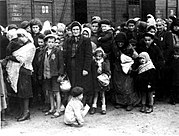
"Selection" on the
Judenrampe,
Auschwitz, May/June 1944. To be sent to the right meant slave labor; to the left, the
gas chambers. This image shows the arrival of Hungarian Jews from
Carpatho-Ruthenia, many of them from the
Berehov ghetto. It was taken by Ernst Hofmann or Bernhard Walter of the SS. Courtesy of
Yad Vashem.
[1]
| The Holocaust |
 |
| |
| |
| |
| |
| |
| |
| |
| |
| |
| |
| |
| v · d · e |
The Holocaust (from the Greek ὁλόκαυστος holókaustos: hólos, "whole" and kaustós, "burnt"),[2] also known as The Shoah (Hebrew: השואה, HaShoah, "calamity"; Yiddish: חורבן, Churben or Hurban,[3] from the Hebrew for "destruction"), was the genocide of approximately six million European Jews during World War II, a programme of systematic state-sponsored extermination by Nazi Germany throughout Nazi-occupied territory.[4] Of the nine million Jews who had resided in Europe before the Holocaust, approximately two-thirds perished.[5] Some scholars maintain that the definition of the Holocaust should also include the Nazis' genocide of millions of people in other groups, including Romani (more commonly known in English by the exonym "Gypsies"), Soviet prisoners of war, Polish and Soviet civilians, homosexuals, people with disabilities, Jehovah's Witnesses and other political and religious opponents, which occurred regardless of whether they were of German or non-German ethnic origin.[6] Using this definition, the total number of Holocaust victims is between 11 million and 17 million people.[7]
The persecution and genocide were carried out in stages. Various legislation to remove the Jews from civil society, predominantly the Nuremberg Laws, was enacted in Nazi Germany years before the outbreak of World War II. Concentration camps were established in which inmates were used as slave labor until they died of exhaustion or disease. Where the Third Reich conquered new territory in eastern Europe, specialized units called Einsatzgruppen murdered Jews and political opponents in mass shootings. The Third Reich required Jews and Romani to be confined in overcrowded ghettos before being transported by freight train to extermination camps where, if they survived the journey, the majority of them were systematically killed in gas chambers.
Every arm of Nazi Germany's bureaucracy was involved in the logistics that led to the genocides, turning the Third Reich into what one Holocaust scholar has called "a genocidal state".[8] Opinions differ on how much the civilian population of Germany knew about the government conspiracy against the Jewish population. Most historians claim that the civilian population was not aware of the atrocities that were carried out, especially in the extermination camps, which were located outside of Germany in Nazi-occupied Europe. The historian Robert Gellately, however, claims that the government openly announced the conspiracy through the media, and that civilians were aware of every aspect of the conspiracy except for the use of gas chambers.[9] Significant historical evidence points to the idea that the vast majority of Holocaust victims, prior to their deportation to concentration camps, were either unaware of the fate that awaited them, or were in disbelief of the information that they had received; they honestly believed that they were to be resettled.
The Holocaust was real. Neo-Nazis often deny it.
 "Selection" on the Judenrampe, Auschwitz, May/June 1944. To be sent to the right meant slave labor; to the left, the gas chambers. This image shows the arrival of Hungarian Jews from Carpatho-Ruthenia, many of them from the Berehov ghetto. It was taken by Ernst Hofmann or Bernhard Walter of the SS. Courtesy of Yad Vashem.[1]
"Selection" on the Judenrampe, Auschwitz, May/June 1944. To be sent to the right meant slave labor; to the left, the gas chambers. This image shows the arrival of Hungarian Jews from Carpatho-Ruthenia, many of them from the Berehov ghetto. It was taken by Ernst Hofmann or Bernhard Walter of the SS. Courtesy of Yad Vashem.[1] Part of: Jewish history
Part of: Jewish history Part of Jewish history
Part of Jewish history
No comments:
Post a Comment